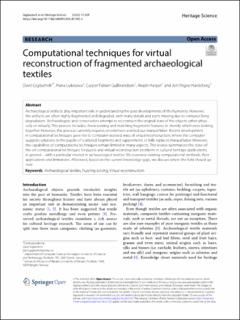| dc.contributor.author | Gigilashvili, Davit | |
| dc.contributor.author | Lukesova, Hana | |
| dc.contributor.author | Gulbrandsen, Casper Fabian | |
| dc.contributor.author | Harijan, Akash | |
| dc.contributor.author | Hardeberg, Jon Yngve | |
| dc.date.accessioned | 2024-04-17T09:00:24Z | |
| dc.date.available | 2024-04-17T09:00:24Z | |
| dc.date.created | 2023-12-13T10:24:52Z | |
| dc.date.issued | 2023 | |
| dc.identifier.issn | 2050-7445 | |
| dc.identifier.uri | https://hdl.handle.net/11250/3126951 | |
| dc.description.abstract | Archaeological artifacts play important role in understanding the past developments of the humanity. However, the artifacts are often highly fragmented and degraded, with many details and parts missing due to centuries’ long degradation. Archaeologists and conservators attempt to reconstruct the original state of the objects either physically or virtually. This process includes characterizing and matching fragments’ features to identify which ones belong together. However, this process currently requires an extensive and tedious manual labor. Recent development in computational techniques gave rise to computer-assisted ways of virtual reconstruction, where the computer suggests solutions to the puzzle of scattered fragments and supplements or fully replaces manual labor. However, the capabilities of computational techniques remain limited in many aspects. This review summarizes the state-of-the-art computational techniques for puzzle and virtual reconstruction problems in cultural heritage applications, in general – with a particular interest in archaeological textiles. We overview existing computational methods, their applications and limitations. Afterward, based on the current knowledge gaps, we discuss where the field should go next. | en_US |
| dc.language.iso | eng | en_US |
| dc.publisher | Springer | en_US |
| dc.relation.uri | https://doi.org/10.1186/s40494-023-01102-3 | |
| dc.rights | Navngivelse 4.0 Internasjonal | * |
| dc.rights.uri | http://creativecommons.org/licenses/by/4.0/deed.no | * |
| dc.title | Computational techniques for virtual reconstruction of fragmented archaeological textiles | en_US |
| dc.type | Journal article | en_US |
| dc.type | Peer reviewed | en_US |
| dc.description.version | publishedVersion | en_US |
| dc.rights.holder | Copyright 2023 The Author(s) | en_US |
| dc.source.articlenumber | 259 | en_US |
| cristin.ispublished | true | |
| cristin.fulltext | original | |
| cristin.qualitycode | 2 | |
| dc.identifier.doi | 10.1186/s40494-023-01102-3 | |
| dc.identifier.cristin | 2212775 | |
| dc.source.journal | Heritage Science | en_US |
| dc.relation.project | Norges forskningsråd: 316268 | en_US |
| dc.identifier.citation | Heritage Science. 2023, 11, 259. | en_US |
| dc.source.volume | 11 | en_US |

